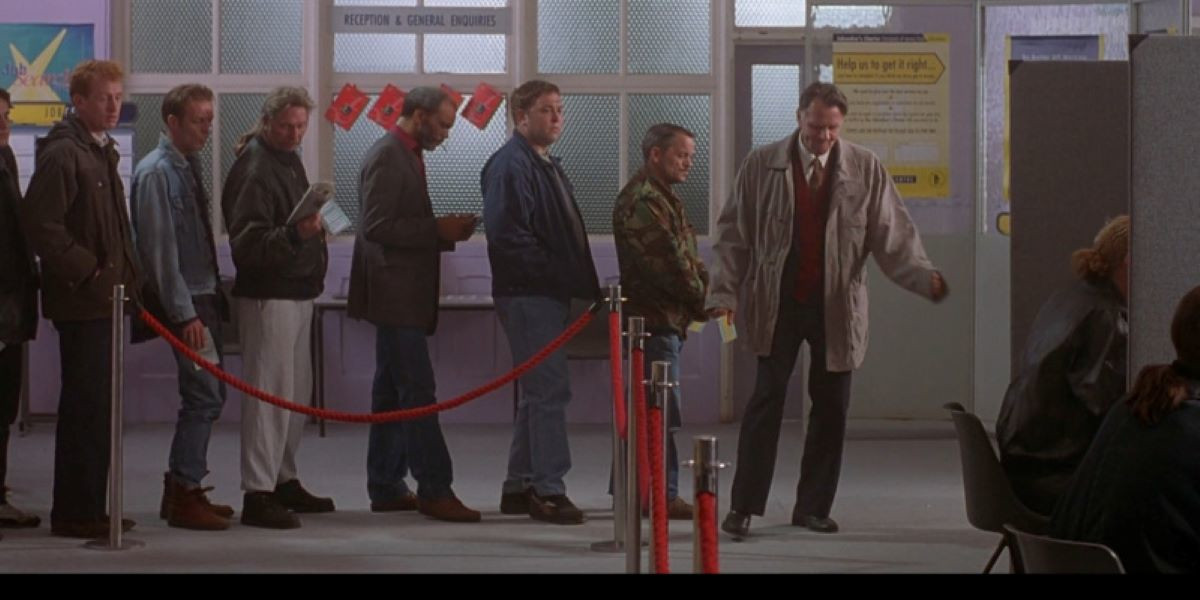Set in Sheffield against a post-Thatcher socioeconomic backdrop, the 1997 film The Full Monty follows six men as they search for work, money and meaning in a fractured landscape where all three are hard to find. The film was and remains a frank yet funny depiction of a northern city scarred by the privatisation of British Steel, high unemployment and two decades of Conservative Party policy.
Twenty-five years since its release, and with a sequel series due in 2023, it’s a good time to ask what The Full Monty world can say about Britain today, when the working class is under threat from a different ilk of Tory rule.
Contrasting landscapes
In the early 1990s, the fallout of a brutal sweep of privatisation and state neglect led to urban degradation and mass unemployment, deeply felt across the north. Today, countrywide, public services battered by the mishandled Covid-19 pandemic are failing. Public mistrust and contempt of government is rising as quickly as the cost of living. Twelve years of Conservative governments, kick-started with David Cameron’s onslaught against the public purse, has pushed more people than ever to foodbanks, into homelessness and into poverty, most recently exacerbated by energy companies hoarding huge profits.
Yet The Full Monty speaks to other, less obvious topics that remain timely today, including its deep dive into fragile masculinity. It shows conversations between men and explorations of their emotional struggles that were unusual for its time.
Dave (Mark Addy) battles with his weight and body image while Lomper (Steve Huison), a depressed former security guard, is rescued from a suicide attempt. Gaz (Robert Carlyle) and Dave’s former boss, Gerald (Tom Wilkinson), is so beset with shame he cannot tell his wife that he lost his job. When Lomper and Guy start a relationship, their friends are quietly accepting – a refreshingly low-key depiction of gay working-class experience. By choosing to earn some cash by stripping, the gang ultimately find strength, purpose and new passion for life.
This ultimately hopeful tone matches that of other popular British films of the era focusing on working-class life, including Brassed Off (1996) and Billy Elliot (2000). Then, a Conservative Party rocked by controversy, economic crisis, sleaze and resignations was fading fast. A calculatedly rebranded Labour, almost 30 points ahead in the polls by 1995, fuelled appetites for stories about northern communities emerging from despair to hope – echoing Labour’s 1997 election anthem, Things Can Only Get Better. The films reflected and helped build a mood of impending social change.
We face a similar political landscape today. With our fifth prime minister in just over six years, Downing Street’s occupants are drowning in failure, confusion and scandal. Keir Starmer’s opposition has experienced a New Labour-like surge, while the Tories have endured their lowest polling ever.
Despite Disney’s involvement, hope remains that 2023’s The Full Monty will use its extended TV run time to deep dive into Tory Britain while retaining its socio-political edge and sharp humour
Once New Labour was in power, however, the British film industry paid less attention to working-class life. Upbeat comedies aimed at aspiring and middle-class viewers dominated, led by directors like Richard Curtis. Writing in 2009, critic Tim Adams concluded: ‘New Labour’s shiny happy geography, in what we have come to know as Curtisland… [is] an apolitical place full of can-do possibility, obsessed with the educated middle-class, perfectly relaxed about the filthy rich.’
About A Boy, Wimbledon and Bridget Jones’ Diary all implied that Britain’s problems had disappeared under New Labour. In reality, income inequality had widened, tuition fees had consolidated higher education into elite hands, anti-social behaviour orders (ASBOs) and attacks on benefit claimants had demonised the poor. Yet few mainstream films dared criticise a Labour government that had once revitalised the sector.
Modern reality
There is little hope today for another streak of New Labour-like optimism. Tony Blair looked energetic and youthful compared to John Major. Keir Starmer has struggled to present an inspiring plan for a post-Tory 2020s Britain, seemingly banking on voters’ dislike for the Tories to push Labour into power, not eagerness for radical change.
Modern Tory Britain has been depicted on screen with little hope in sight. Compare the two dole scenes in The Full Monty and I, Daniel Blake. In 1997, the gang tap their feet as Donna Summers’ Hot Stuff plays on the radio, eventually breaking into a dance routine. Ken Loach’s 2016 film, in contrast, presents a deeply upsetting scene, exposing how the Tory-run welfare system punishes people simply running late for a meeting by refusing them pay.
British comedy dramas are still being produced, of course, to far less acclaim. Feelgood films like Fisherman’s Friends highlight contrasts between fast-paced, profit-driven urban experience and single-industry local community life. Military Wives explores the effects of war on people at home and how friendship can allay grief and loneliness. The politics of each film ultimately suggests acceptance, however – to make the best of your lot – and present little critique of the social structures behind people’s isolation.
The Full Monty captured the mood and feel of Britain at a particular point in time but followed a difficult production and was not initially tipped for success. The sequel TV series, expected next year, is being produced by Disney – not known for its insight to British working-class life. The international film industry is being monopolised into fewer hands – with threats to privatise Channel 4 and Film 4 quietened but still lingering under the Sunak government – reducing avenues for working-class filmmakers and screenwriters at a time when their insights are desperately needed.
Despite Disney’s involvement, hope remains that 2023’s The Full Monty will use its extended TV run time to deep dive into Tory Britain while retaining its socio-political edge and sharp humour. Alongside critique, we sorely need more working-class joy on screen.
You’ve got to laugh
The British film and TV sector often presents working-class people and communities in constant misery and defeat, with the rare dreamer character battling to escape a rainy hometown for brighter horizons. When not faced with misery, we’re asked to laugh at or condemn the working class. Little Britain, which coincided with the latter Blair years, and reality TV show Benefits Street, aired at the height of the Cameron government’s austerity regime, both encouraged middle-class ridicule of hideous and uncivilised working-class communities.
Such shows invent rather than reflect stereotypes, condemning people for trying to survive in an economy designed to keep people poor. They imply that being working-class is a punishable crime, a status anyone sane would try to escape. Putting working-class laughter and joy on screen is a necessary antidote to damaging messages that only shore up elite power – and it is needed no matter which party is in Downing Street. It shouldn’t take a Conservative government ruining people’s lives for us to see ordinary people’s lives – the vast majority of the UK population is working-class – on screen.
With another centrist Labour government coming into view, we must not yet again abandon working-class voices and stories, nor demonise working people when it tries to hide its cruel intentions behind a liberal façade. For now, we should hope that Disney’s The Full Monty is both funny and cutting, able to shine a light on Conservative Britain and everything it does to keep us struggling, while reminding us of the power and solidarity that exists within working-class communities.










